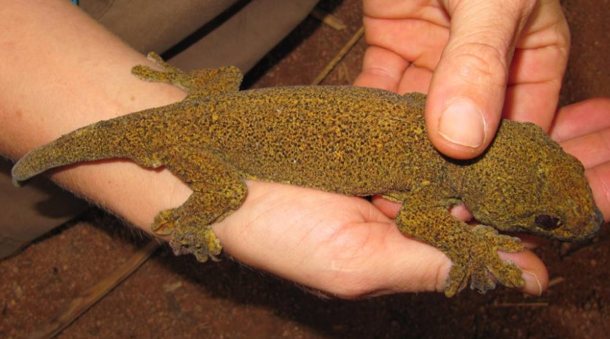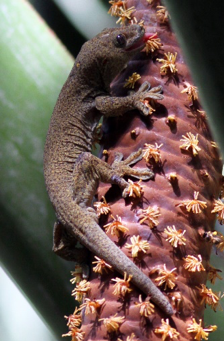The long and winding road to protecting a giant island endemic
- ConScience

- Feb 3, 2022
- 5 min read
Updated: Sep 1, 2022
By Nancy Bunbury, Director of Research and Conservation for the Seychelles Islands Foundation. SIF protects and manages the two UNESCO World Heritage sites of Seychelles, one of which is the Vallée de Mai palm forest, among the last areas of palm-dominated forest in the world.
The giant bronze gecko, Ailuronyx trachygaster (Photos: D. Hansen & SIF)
A mysterious and magnificent gecko, endemic to Seychelles, has been so shrouded in false information that, despite being among the world’s largest geckos, remains barely known to the outside world. It inhabits a very rare forest type on one small island, with a total range of no more than 4 km2. Protection was greatly needed, but took years to enact. I write this to describe some of the complexities of securing protection, and to share the back story of how a species long served poorly by science was eventually protected.
The giant
The giant bronze gecko Ailuronyx trachygaster is a massive, charismatic, canopy denizen of mature coco de mer palm forest on the island of Praslin. The coco de mer itself is a giant botanical wonder, producing the largest seeds in the plant kingdom. The giant geckos depend on coco de mer forest because they need continuous canopy to move around. They are clumsy on the ground, making them easy targets for predators. But in the other-worldly canopy of enormous overlapping coco de mer leaves, they reign supreme. They can grow to almost 30 cm long, making them the world’s fourth largest gecko. Their baggy, wrinkled skin and upturned mouth lend them an ancient, wise and incongruously benevolent appearance.
They, and their favoured trees, are stunning examples of island gigantism and a rare case of extant co-dependent island giants.

Giant bronze gecko ‘smile’ (photo: L. Chongseng)
Scientific misconceptions and conservation consequences
The giant bronze gecko has had a 10 million year evolutionary lineage in Seychelles, but its Seychelles origin and endemic status was not known until 1990. The holotype was collected in the early 1800s and incorrectly labelled as from Madagascar, so for nearly 200 years the species was thought to be a Malagasy gecko. Another claim, made in the early 2000s, that the species occurred on the island of Silhouette as well as on Praslin, was unsubstantiated yet persisted for many years.
As a result, for 20 years, the species was widely considered, to have a far larger range and extent of occurrence than it actually has. This compromised conservation planning, action and protective legislation for the species, as well as the sense of conservation urgency, for more than a decade.
It was also not known until fairly recently that A. trachygaster is restricted to one rare forest type on Praslin. Because the species was so little known, and plagued by misinformation, it had no formal protection (although it was assessed as ‘Vulnerable’ on the IUCN Red List).
Re-writing the script
SIF realised 10 years ago that A. trachygaster deserved substantially more research and conservation attention. With very little budget, we recruited MSc students to study the species and gather basic ecological and morphometric data, initiated a pit-tagging study, and increased research on the coco de mer. Piece by piece, the picture emerged that not only does this gecko not occur on Silhouette (which has no continuous coco de mer forest), but almost certainly occurs nowhere outside mature coco de mer forest on Praslin, and it is very likely to be a keystone species in the palm forest (more on this in another post!).
In short, this essential and misunderstood species was not only far more threatened than its Red List assessment and lack of protection implied, but it plays a crucial ecological role in the highly threatened and declining palm forest.

A large adult giant bronze gecko on a coco de mer petiole in the Vallée de Mai palm forest (photo: D. Hansen)
Emergence of a new threat
In 2017, we started receiving reports of poached A. trachygaster being trafficked to Europe. Investigation revealed that they were being openly sold for $10,000–$20,0000 per pair (juveniles for $7500 – yes, correct number of zeroes!). This was a new and alarming threat, but was virtually impossible to address. The species was not CITES-listed, and had no specific national legislative protection at the time (even the IUCN couldn’t consider reassessment because herpetofauna updates were not planned that year).
It was beyond frustrating that technically, nobody was doing anything wrong in capturing and exporting A. trachygaster, yet, from the numbers reported by social media and contacts, we estimate that approx. 4% of the entire global population of the species was taken in less than a year for the captive herpetofauna trade.
The Seychelles government took the new threat seriously and made every attempt to identify and intercept the poachers and traffickers but unfortunately with no success. A case was also collated to protect the species under national legislation.

Screenshot of facebook page advertising giant bronze geckos for sale in 2017
CITES and national legislative progress
With the Seychelles government in 2018 we compiled an NDF (Non-detriment Findings) report for CITES, which compiles everything known about a species and its threats, and submitted it for consideration at the CITES Conference of the Parties. The meeting was delayed but we were eventually told that any proposed species for CITES listing needs to first have national protection. This was a blow, despite the logic; the wheels for national protection had been turning, slowly, but this gave the national efforts new impetus. The new regulation was prepared in 2020 and finally gazetted in early 2021 so A. trachygaster is now afforded protection (under the “Wild Animals [Bronze gecko, Ailuronyx ssp] Protection Regulations”, under which the taking or killing or purchase of any of the three species of bronze gecko is prohibited).
Eventually, in 2020, the IUCN re-assessed some herpetofauna taxa and involved SIF in the update for A. trachygaster, with the outcome that, as of December 2021, the species is now listed as Critically Endangered.
So IUCN and national protection are in place but the gecko is still not listed by CITES. Incidentally, the coco de mer, another endangered and heavily poached species, whose giant nuts selling for several hundred euros each, is now CITES-listed, which substantially improved its protection.
Protection as a marathon
Protecting species, even iconic ones, can be a marathon – a lengthy and galling process. For species that need national legislation, Red List, and CITES listings, it can be very difficult to align all three processes, alongside research and local knowledge (and public outreach), so that they support and complement each other (e.g. in this case, the Red List assessment doesn’t mention the national legislation although it was published after the legislation was gazetted – because of the delay between finalising and publishing the update), which undermines everyone’s goal of protection. Moreover, setting the record straight on species absences (i.e. where species have been claimed to occur but don’t) and incorrect records is not only time-consuming but can set conservation efforts back several years.
For the giant bronze gecko, 20 years was spent first accepting then unpicking incorrect information, then trying to verify the absence of this cryptic species from one of its claimed areas of occupancy, and finally attempting to correct the official record, which I’m relieved to finally be able to write, has now been done. The next step is CITES listing, and a lot more research!









Comments